————————————————————————————————-
-
Types
of word combinations. Classifications of word-groups. -
Free
word groups. -
Phraseology
as a subsystem of language. -
A
phraseological unit. -
Distinction
between free word-groups and phraseological
units. -
Classification
of phraseological units. -
Sources
of phraseological units.
————————————————————————————————-
1. Types of word combinations. Classifications of word-groups
The
vocabulary of any language consists not only of words but also of
different word groups and expressions.
Words put together to form lexical units make phrases or word-groups.
A word-combination (word-group) is a combination of two or more
words organizes according to the norms of the language. There are
three types of word-groups: 1) free; 2) semi-free (устойчивые);
3) phraseological units.
They are
different structurally and semantically.
2. Free word groups
Free
word combinations
are structurally and semantically unstable, e.g. a
good man;
a
good and reliable man;
a better man,
a
good woman.
They are characterized by the following features:
-
They are
made up by the speaker; they are productive. -
Each word
in a free word combination realizes its own meaning. For example, in
the word-combination a
red rose,
to
write a letter,
extremely
dangerous,
each word has its own meaning, and the meaning of the whole phrase
is the sum of the meanings of its components. -
Substitution
is possible in them.
to walk
fast
to
walk
slowly to move fast
forward
to run
backward
to go
in
the park to drive
in
the forest to fly
Semi-free
or
Fixed
combinations
of
words are
structurally and semantically stable and the meaning is understood
from the meanings of the components. That means there is no
transference of meaning of these combinations, e.g. a
man of business;
a
man of letters
(писатель).
They stand midway between free word-combinations and phrasiological
units. They are characterized in the following way:
-
They are
fixed because they are not made up in speech but are used as
ready-made units. -
The
meaning of the whole can be inferred from the meanings of its
components. -
They are
transitional, semi-productive.
Examples:
soft
landing,
to
commit suicide,
good
luck,
black
coffee,
Merry
Christmas,
Good
afternoon.
3. Phraseology as a subsystem of language
Phraseology
is
a branch of lexicology which studies different types of fixed
expressions, which like words name various objects and phenomena.
They are not created by the speaker but exist in the language as
ready-made units. These word-groups are characterized by stability of
structure and transferred (перенос)
meaning (take
the bull by the horn
–действовать
решительно,
напрямик
= брать
быка
за
рога);
(to
burn one’s boats –
совершать
решительный
поступок,
бесповоротно
разрывая
с
прошлым
= сжечь
корабли);
(to
eat a bushel of salt with –
очень
долгое
время
общаясь,
хорошо
узнать
кого-либо
= съесть
пуд
соли).
Соседние файлы в предмете [НЕСОРТИРОВАННОЕ]
- #
- #
- #
- #
30.04.2022451 Кб2Учебник 213.docx
- #
- #
- #
- #
- #
- #
- #
Clark is right; without definitions (and a context) we end up talking in circles.
You’re probably thinking of traditional grammar, which is based on «parts of speech», which are word-classes. In traditional grammar, phrases are, by definition, word groups (as are clauses). So from the traditional perspective you’re right:
«Cat» is a word, but it’s not a «phrase».
I was using a different framework: structural grammar (in the wider sense, which includes both structural and transformational grammars). Structural grammars are based on structures (formal relationships) rather than words, so that «phrase» is defined as a set of relationships rather than as an «item» (so is «word», and so is «clause»).
I think the easiest way to explain this is through immediate constituents. Basically, the idea is that:
— sentences consist of clauses
— clauses consist of phrases
— phrases consist of words.
(- words consist of morphemes)
There’s still a broad range of definitions within structural grammars, and we don’t have to go into that here (it would take too long). But what they have in common is a focus on the relationship between immediate constituents (on the same level, and in between levels).
Now what’s the difference between traditional grammar and structural grammar?
In traditional grammar words and phrases are viewed as «things». So, «cat» is a word; «orange cat» is two words, a word group, a phrase.
In functional grammar, «word» and «phrase» are ways of looking at things. «Cats» can be both a word or a phrase, depending on what level we look at it.
Sentence: [I like cats.]
Clause: [[I like cats].]
phrases: [[[like][cats]].]
words: [[[][[like]][[cats]]].]
So you see that just as the sentence is identical with the main clause, the word «cats» is identical with phrase «cats». If the sentence had read «I like orange cats,» then the phrase would have been «orange cats» and it would have contained two words.
You have probably noticed that I changed the example to the plural. That’s because «cat» is rather rare as a phrase in English. It would be possible to say something like:
I’ve never eaten cat. (Where «cat» means «cat meat».)
Or, you might hear someone say things like: «Cat’s been in the garden again.» But this is at best highly informal, and probably non-standard English. Singular nouns in English usually take a determiner (an article or a pronoun), so you’re very unlikely to encounter them alone in a phrase.
Nevertheless, there are circumstances when you can point at the same «physical unit» (sounds or letters) and say «word» or «phrase» depending on what constituent-level you’re currently analysing.
I apologise for not laying open the theoretical framework earlier. Traditional and structural grammars have a very different method of looking at language (and in consequence of naming its parts).
I realise that this can be difficult at first, but I think understanding structural grammar terminology can help you learn languages, because different languages have different structures, and with structural terminology you’re forced to think about this.
I hope this is a better explanation. It’s still not what I’d call a «clear» definition; more a pointing out of the difference in approach. Thank you for helping me think this through. You’re asking the right questions.
Free word groups and phraseological units
A word-group is the largest two-facet lexical unit comprising more than one word but expressing one global concept.
The lexical meaning of the word groups is the combined lexical meaning of the component words. The meaning of the word groups is motivated by the meanings of the component members and is supported by the structural pattern. But it’s not a mere sum total of all these meanings! Polysemantic words are used in word groups only in 1 of their meanings. These meanings of the component words in such word groups are mutually interdependent and inseparable (blind man – «a human being unable to see», blind type – «the copy isn’t readable).
Word groups possess not only the lexical meaning, but also the meaning conveyed mainly by the pattern of arrangement of their constituents. The structural pattern of word groups is the carrier of a certain semantic component not necessarily dependent on the actual lexical meaning of its members (school grammar – «grammar which is taught in school», grammar school – «a type of school»). We have to distinguish between the structural meaning of a given type of word groups as such and the lexical meaning of its constituents.
It is often argued that the meaning of word groups is also dependent on some extra-linguistic factors – on the situation in which word groups are habitually used by native speakers.
Words put together to form lexical units make phrases or word-groups. One must recall that lexicology deals with words, word-forming morphemes and word-groups.
The degree of structural and semantic cohesion of word-groups may vary. Some word-groups, e.g. at least, point of view, by means, to take place, etc. seem to be functionally and semantically inseparable. They are usually described as set phrases, word-equivalents or phraseological units and are studied by the branch of lexicology which is known as phraseology. In other word-groups such as to take lessons, kind to people, a week ago, the component-members seem to possess greater semantic and structural independence. Word-groups of this type are defined as free word-groups or phrases and are studied in syntax.
Before discussing phraseology it is necessary to outline the features common to various word-groups irrespective of the degree of structural and semantic cohesion of the component-words.
There are two factors which are important in uniting words into word-groups:
– the lexical valency of words;
– the grammatical valency of words.
Lexical valency
Words are used in certain lexical contexts, i.e. in combinations with other words. E.g. the noun question is often combined with such adjectives as vital, pressing, urgent, delicate, etc.
The aptness of a word to appear in various combinations is described as its lexical valency. The range of the lexical valency of words is delimited by the inner structure of the English words. Thus, to raise and to lift are synonyms, but only the former is collocated with the noun question. The verbs to take, to catch, to seize, to grasp are synonyms, but they are found in different collocations:
to take – exams, measures, precautions, etc.;
to grasp – the truth, the meaning.
Words habitually collocated in speech tend to form a cliche.
The lexical valency of correlated words in different languages is not identical, because as it was said before, it depends on the inner structure of the vocabulary of the language. Both the English flower and the Russian цветок may be combined with a number of similar words, e.g. garden flowers, hot house flowers (cf. the Russian – садовые цветы, оранжерейные цветы), but in English flower cannot be combined with the word room, while in Russian we say комнатные цветы (in English we say pot-flowers).
Words are also used in grammatical contexts. The minimal grammatical context in which the words are used to form word-groups is usually described as the pattern of the word-group. E.g., the adjective heavy can be followed by a noun (A+N) – heavy food, heavy storm, heavy box, heavy eater. But we cannot say «heavy cheese» or «heavy to lift, to carry», etc.
The aptness of a word to appear in specific grammatical (or rather syntactical) structures is termed grammatical valency.
The grammatical valency of words may be different. The grammatical valency is delimited by the part of speech the word belongs to. E.g., no English adjective can be followed by the finite form of a verb.
Then, the grammatical valency is also delimited by the inner structure of the language. E.g., to suggest, to propose are synonyms. Both can be followed by a noun, but only to propose can be followed by the infinitive of a verb – to propose to do something.
Clever and intelligent have the same grammatical valency, but only clever can be used in word-groups having the pattern A+prep+N – clever at maths.
Structurally word-groups can be considered in different ways. Word-groups may be described as for the order and arrangement of the component-members. E.g., the word-group to read a book can be classified as a verbal-nominal group, to look at smb. – as a verbal-prepositional-nominal group, etc.
By the criterion of distribution all word-groups may be divided into two big classes: according to their head-words and according to their syntactical patterns.
Word-groups may be classified according to their head-words into:
nominal groups – red flower;
adjective groups – kind to people;
verbal groups – to speak well.
The head is not necessarily the component that occurs first.
Word-groups are classified according to their syntactical pattern into predicative and non-predicative groups. Such word-groups as he went, Bob walks that have a syntactic structure similar to that of a sentence are termed as predicative, all others are non-predicative ones.
Non-predicative word-groups are divided into subordinative and coordinative depending on the type of syntactic relations between the components. E.g., a red flower, a man of freedom are subordinative non-predicative word-groups, red and freedom being dependent words, while day and night, do and die are coordinative non-predicative word-groups.
The lexical meaning of a word-group may be defined as the combined lexical meaning of the component members. But it should be pointed out, however, that the term «combined lexical meaning» does not imply that the meaning of the word-group is always a simple additive result of all the lexical meanings of the component words. As a rule, the meanings of the component words are mutually dependent and the meaning of the word-group naturally predominates over the lexical meaning of the components. The interdependence is well seen in word-groups made up of polysemantic words. E.g., in the phrases the blind man, the blind type the word blind has different meanings – unable to see and vague.
So we see that polysemantic words are used in word-groups only in one of their meanings.
The term motivation is used to denote the relationship existing between the phonemic or morphemic composition and structural pattern of the word on the one hand and its meaning on the other.
There are three main types of motivation:
1) phonetical
2) morphological
3) semantic
1. Phonetical motivation is used when there is a certain similarity between the sounds that make up the word. For example: buzz, cuckoo, gigle. The sounds of a word are imitative of sounds in nature, or smth that produces a characteristic sound. This type of motivation is determined by the phonological system of each language.
2. Morphological motivation – the relationship between morphemic structure and meaning. The main criterion in morphological motivation is the relationship between morphemes. One-morphemed words are non-motivated. Ex – means «former» when we talk about humans ex-wife, ex-president. Re – means «again»: rebuild, rewrite. In borowed words motivation is faded: «expect, export, recover (get better)». Morphological motivation is especially obvious in newly coined words, or in the words created in this century. In older words motivation is established etymologically.
The structure-pattern of the word is very important too: «finger-ring» and «ring-finger». Though combined lexical meaning is the same. The difference of meaning can be explained by the arrangement of the components.
Morphological motivation has some irregularities: «smoker» – si not «the one who smokes», it is «a railway car in which passenger may smoke».
The degree of motivation can be different:
«endless» is completely motivated
«cranberry» is partially motivated: morpheme «cran-» has no lexical meaning.
3. Semantic motivation is based on the co-existence of direct and figurative meanings of the same word within the same synchronous system. «Mouth» denotes a part of the human face and at the same time it can be applied to any opening: «the mouth of a river». «Ermine» is not only the anme of a small animal, but also a fur. In their direct meaning «mouth» and «ermine» are not motivated.
In compound words it is morphological motivation when the meaning of the whole word is based on direct meanings of its components and semantic motivation is when combination of components is used figuratively. For example «headache» is «pain in the head» (morphological) and «smth. annoying» (sematic).
When the connection between the meaning of the word and its form is conventional (there is no perceptible reason for the word having this phonemic and morphemic composition) the word is non-motivated (for the present state of language development). Words that seem non-motivated now may have lost their motivation: «earn» is derived from «earnian – to harvest», but now this word is non-motivated.
As to compounds, their motivation is morphological if the meaning of the whole is based on the direct meaning of the components, and semantic if the combination is used figuratively: watchdog – a dog kept for watching property (morphologically motivated); – a watchful human guardian (semantically motivated).
Every vocabulary is in a state of constant development. Words that seem non-motivated at present may have lost their motivation. When some people recognize the motivation, whereas others do not, motivation is said to be faded.
Semantically all word-groups may be classified into motivated and non-motivated. Non-motivated word-groups are usually described as phraseological units or idioms.
Word-groups may be described as lexically motivated if the combined lexical meaning of the groups is based on the meaning of their components. Thus take lessons is motivated; take place – ‘occur’ is lexically non-motivated.
Word-groups are said to be structurally motivated if the meaning of the pattern is deduced from the order and arrangement of the member-words of the group. Red flower is motivated as the meaning of the pattern quality – substance can be deduced from the order and arrangement of the words red and flower, whereas the seemingly identical pattern red tape (‘official bureaucratic methods’) cannot be interpreted as quality – substance.
Seemingly identical word-groups are sometimes found to be motivated or non-motivated depending on their semantic interpretation. Thus apple sauce, e.g., is lexically and structurally motivated when it means ‘a sauce made of apples’ but when used to denote ‘nonsense’ it is clearly non-motivated
Word-groups like words may be also analyzed from the point of view of their motivation. Word-groups may be called as lexically motivated if the combined lexical meaning of the group is deducible from the meaning of the components. All free phrases are completely motivated.
It follows from the above discussion that word-groups may be also classified into motivated and non-motivated units. Non-motivated word-groups are habitually described as phraseological units or idioms.
Investigations of English phraseology began not long ago. English and American linguists as a rule are busy collecting different words, word-groups and sentences which are interesting from the point of view of their origin, style, usage or some other features. All these units are habitually described as «idioms», but no attempt has been made to describe these idioms as a separate class of linguistic units or a specific class of word-groups.
Difference in terminology («set-phrases», «idioms» and «word-equivalents») reflects certain differences in the main criteria used to distinguish types of phraseological units and free word-groups. The term «set phrase» implies that the basic criterion of differentiation is stability of the lexical components and grammatical structure of word-groups.
There is a certain divergence of opinion as to the essential features of phraseological units as distinguished from other word-groups and the nature of phrases that can be properly termed «phraseological units». The habitual terms «set-phrases», «idioms», «word-equivalents» are sometimes treated differently by different linguists. However these terms reflect to certain extend the main debatable points of phraseology which centre in the divergent views concerning the nature and essential features of phraseological units as distinguished from the so-called free word-groups.
The term «set expression» implies that the basic criterion of differentiation is stability of the lexical components and grammatical structure of word-groups.
The term «word-equivalent» stresses not only semantic but also functional inseparability of certain word-groups, their aptness to function in speech as single words.
The term «idioms» generally implies that the essential feature of the linguistic units under consideration is idiomaticity or lack of motivation. Uriel Weinreich expresses his view that an idiom is a complex phrase, the meaning of which cannot be derived from the meanings of its elements. He developed a more truthful supposition, claiming that an idiom is a subset of a phraseological unit. Ray Jackendoff and Charles Fillmore offered a fairly broad definition of the idiom, which, in Fillmore’s words, reads as follows: «…an idiomatic expression or construction is something a language user could fail to know while knowing everything else in the language». Chafe also lists four features of idioms that make them anomalies in the traditional language unit paradigm: non-compositionality, transformational defectiveness, ungrammaticality and frequency asymmetry.
Great work in this field has been done by the outstanding Russian linguist A. Shakhmatov in his work «Syntax». This work was continued by Acad. V.V. Vinogradov. Great investigations of English phraseology were done by Prof. A. Cunin, I. Arnold and others.
Phraseological units are habitually defined as non-motivated word-groups that cannot be freely made up in speech but are reproduced as ready-made units; the other essential feature of phraseological units is stability of the lexical components and grammatical structure.
Unlike components of free word-groups which may vary according to the needs of communication, member-words of phraseological units are always reproduced as single unchangeable collocations. E.g., in a red flower (a free phrase) the adjective red may be substituted by another adjective denoting colour, and the word-group will retain the meaning: «the flower of a certain colour».
In the phraseological unit red tape (bürokratik metodlar) no such substitution is possible, as a change of the adjective would cause a complete change in the meaning of the group: it would then mean «tape of a certain colour». It follows that the phraseological unit red tape is semantically non-motivated, i.e. its meaning cannot be deduced from the meaning of its components, and that it exists as a ready-made linguistic unit which does not allow any change of its lexical components and its grammatical structure.
Grammatical structure of phraseological units is to a certain degree also stable:
red tape – a phraseological unit;
red tapes – a free word-group;
to go to bed – a phraseological unit;
to go to the bed – a free word-group.
Still the basic criterion is comparative lack of motivation, or idiomaticity of the phraseological units. Semantic motivation is based on the coexistence of direct and figurative meaning.
Taking into consideration mainly the degree of idiomaticity phraseological units may be classified into three big groups. This classification was first suggested by Acad. V.V. Vinogradov. These groups are:
– phraseological fusions,
– phraseological unities,
– phraseological collocations, or habitual collocations.
Phraseological fusions are completely non-motivated word-groups. Themeaning of the components has no connection at least synchronically with the meaning of the whole group. Idiomaticity is combined with complete stability of the lexical components and the grammatical structure of the fusion.
Phraseological unities are partially non-motivated word-groups as their meaning can usually be understood through (deduced from) the metaphoric meaning of the whole phraseological unit.
Phraseological unities are usually marked by a comparatively high degree of stability of the lexical components and grammatical structure. Phraseological unities can have homonymous free phrases, used in direct meanings.
§ to skate on thin ice – to skate on thin ice (to risk);
§ to wash one’s hands off dirt – to wash one’s hands off (to withdraw from participance);
§ to play the first role in the theatre – to play the first role (to dominate).
There must be not less than two notional wordsin metaphorical meanings.
Phraseological collocations are partially motivated but they are made up of words having special lexical valency which is marked by a certain degree of stability in such word-groups. In phraseological collocations variability of components is strictly limited. They differ from phraseological unities by the fact that one of the components in them is used in its direct meaning, the other – in indirect meaning, and the meaning of the whole group dominates over the meaning of its components. As figurativeness is expressed only in one component of the phrase it is hardly felt.
§ to pay a visit, tribute, attention, respect;
§ to break a promise, a rule, news, silence;
§ to meet demands, requirement, necessity;
§ to set free; to set at liberty;
§ to make money, journey;
§ to fall ill.
The structure V + N (дополнение) is the largest group of phraseological collocations.
Phraseological units may be defined as specific word-groups functioning as word-equivalents; they are equivalent to definite classes of words. The part-of-speech meaning of phraseological units is felt as belonging to the word-group as a whole irrespective of the part-of-speech meaning of component words. Comparing a free word-group, e.g. a long day and a phraseological unit, e.g. in the long run, we observe that in the free word-group the noun day and the adjective long preserve the part-of-speech meaning proper to these words taken in isolation. The whole group is viewed as composed of two independent units (A + N). In the phraseological unit in the long run the part-of-speech meaning belongs to the group as a single whole. In the long run is grammatically equivalent to single adverbs, e.g. finally, firstly, etc.
So, phraseological units are included into the system of parts of speech.
Phraseological units are created from free word-groups. But in the course of time some words – constituents of phraseological units may drop out of the language; the situation in which the phraseological unit was formed can be forgotten, motivation can be lost and these phrases become phraseological fusions.
The vocabulary of a language is enriched not only by words, but also by phraseological units. Phraseological units are word-groups that cannot be made in the process of speech, they exist in the language as ready-made units. They are compiled in special dictionaries. The same as words phraseological units express a single notion and are used in a sentence as one part of it. American and British lexicographers call such units «idioms». We can mention such dictionaries as: L. Smith «Words and Idioms», V. Collins «A Book of English Idioms» etc. In these dictionaries we can find words, peculiar in their semantics (idiomatic), side by side with word-groups and sentences. In these dictionaries they are arranged, as a rule, into different semantic groups.
Phraseological units can be classified according to the ways they are formed, according to the degree of the motivation of their meaning, according to their structure and according to their part-of-speech meaning.
A.V. Koonin classified phraseological units according to the way they are formed. He pointed out primary and secondary ways of forming phraseological units.
Among two-top units A.I. Smirnitsky points out the following structural types:
a) attributive-nominal such as: a month of Sundays, grey matter, a millstone round one’s neck and many others. Units of this type are noun equivalents and can be partly or perfectly idiomatic. In partly idiomatic units (phrasisms) sometimes the first component is idiomatic, e.g. high road, in other cases the second component is idiomatic, e.g. first night. In many cases both components are idiomatic, e.g. red tape, blind alley, bed of nail, shot in the arm and many others.
b) verb-nominal phraseological units, e.g. to read between the lines, to speak BBC, to sweep under the carpet etc. The grammar centre of such units is the verb, the semantic centre in many cases is the nominal component, e.g. to fall in love. In some units the verb is both the grammar and the semantic centre, e.g. not to know the ropes. These units can be perfectly idiomatic as well, e.g. to burn one’s boats, to vote with one’s feet, to take to the cleaners’ etc.
Very close to such units are word-groups of the type to have a glance, to have a smoke. These units are not idiomatic and are treated in grammar as a special syntactical combination, a kind of aspect.
c) phraseological repetitions, such as: now or never, part and parcel, country and western etc. Such units can be built on antonyms, e.g. ups and downs, back and forth; often they are formed by means of alliteration, e.g cakes and ale, as busy as a bee. Components in repetitions are joined by means of conjunctions. These units are equivalents of adverbs or adjectives and have no grammar centre. They can also be partly or perfectly idiomatic, e.g. cool as a cucumber (partly), bread and butter (perfectly).
Phraseological units the same as compound words can have more than two tops (stems in compound words), e.g. to take a back seat, a peg to hang a thing on, lock, stock and barrel, to be a shadow of one’s own self, at one’s own sweet will.
Phraseological units can be classified as parts of speech. This classification was suggested by I.V. Arnold. Here we have the following groups:
a) noun phraseologisms denoting an object, a person, a living being, e.g. bullet train, latchkey child, redbrick university, Green Berets,
b) verb phraseologisms denoting an action, a state, a feeling, e.g. to break the log-jam, to get on somebody’s coattails, to be on the beam, to nose out, to make headlines,
c) adjective phraseologisms denoting a quality, e.g. loose as a goose, dull as lead
d) adverb phraseological units, such as: with a bump, in the soup, like a dream, like a dog with two tails,
e) preposition phraseological units, e.g. in the course of, on the stroke of,
f) interjection phraseological units, e.g. «Catch me!», «Well, I never!» etc.
In I.V. Arnold’s classification there are also sentence equivalents, proverbs, sayings and quotations, e.g. «The sky is the limit», «What makes him tick», «I am easy». Proverbs are usually metaphorical, e.g. «Too many cooks spoil the broth», while sayings are as a rule non-metaphorical, e.g. «Where there is a will there is a way».
Теги:
Free word groups. Phraseological units
Контрольная работа
Английский
Просмотров: 27377
Найти в Wikkipedia статьи с фразой: Free word groups. Phraseological units
- Размер: 211 Кб
- Количество слайдов: 39
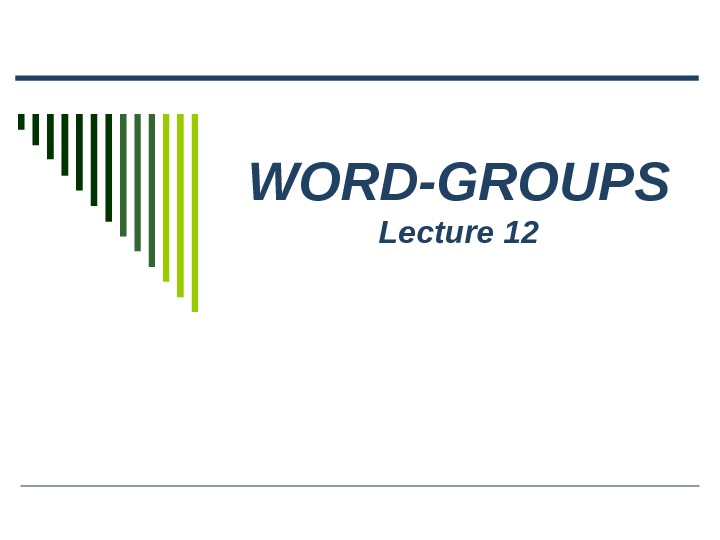
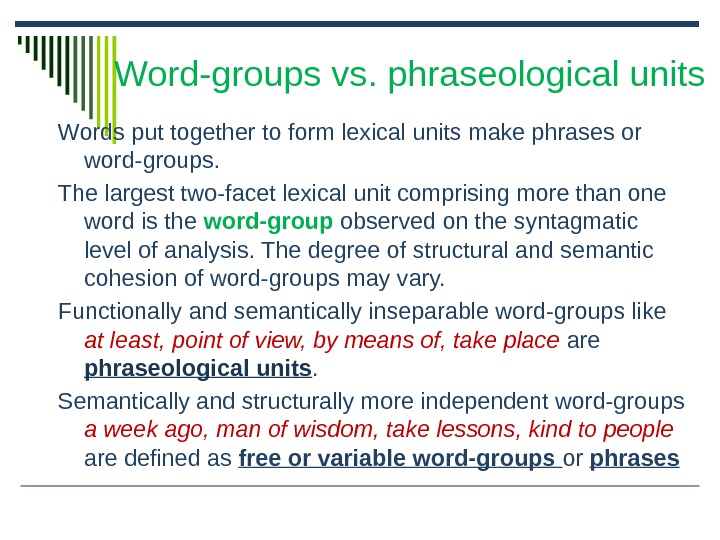
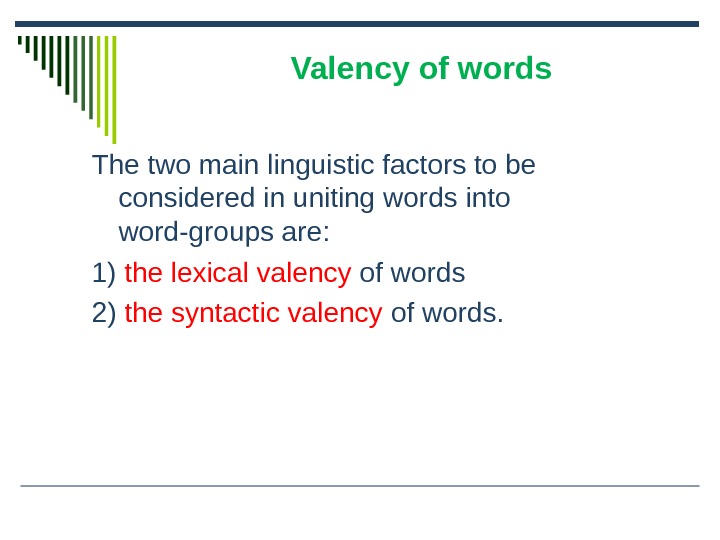
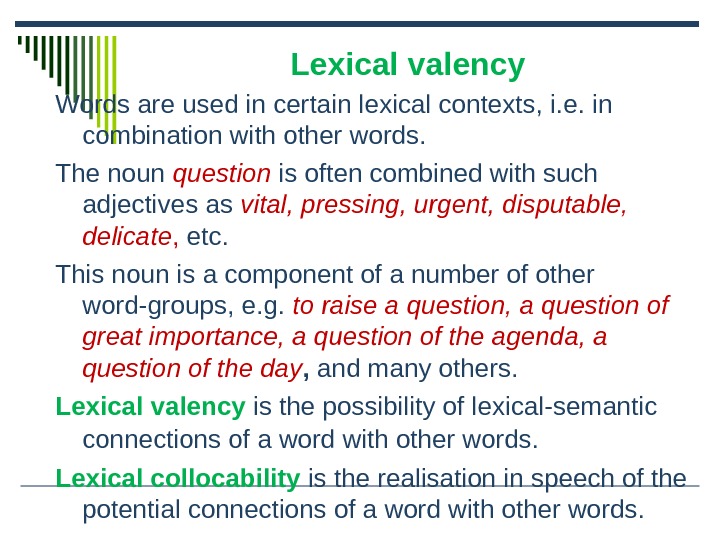
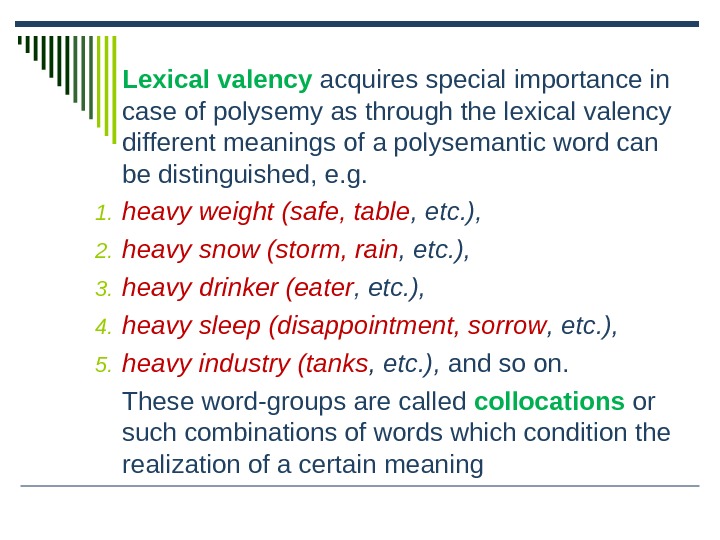
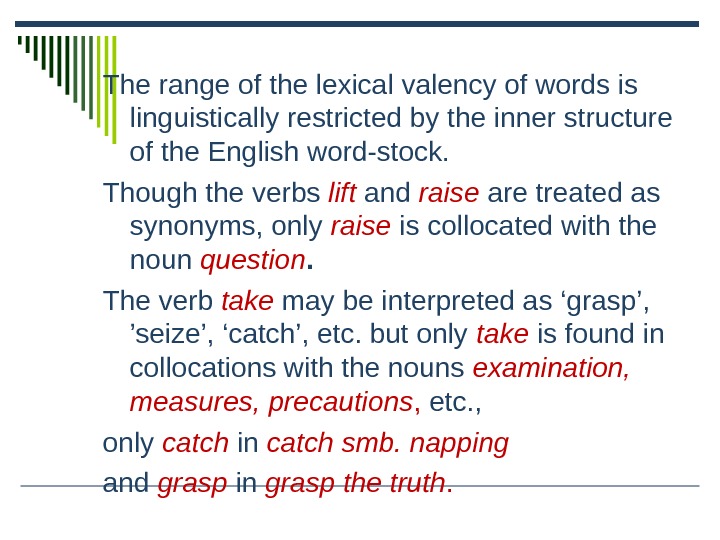
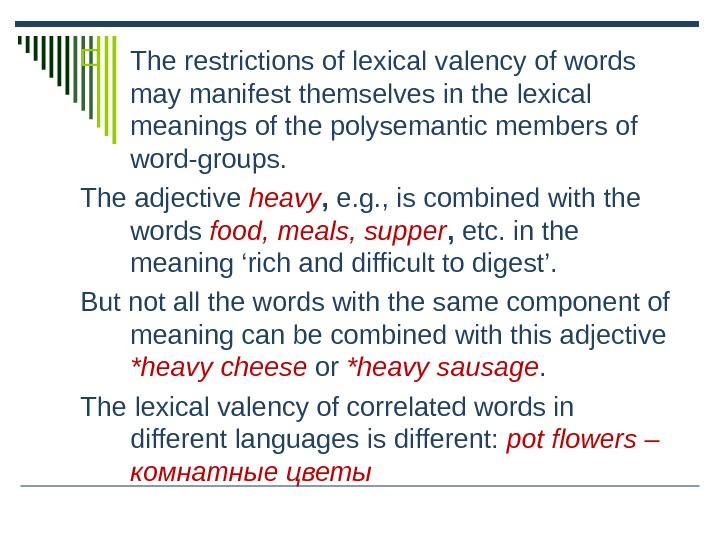
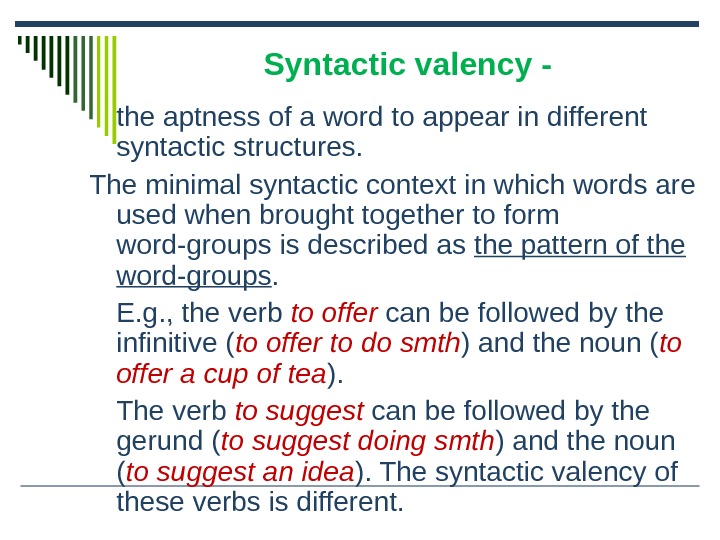
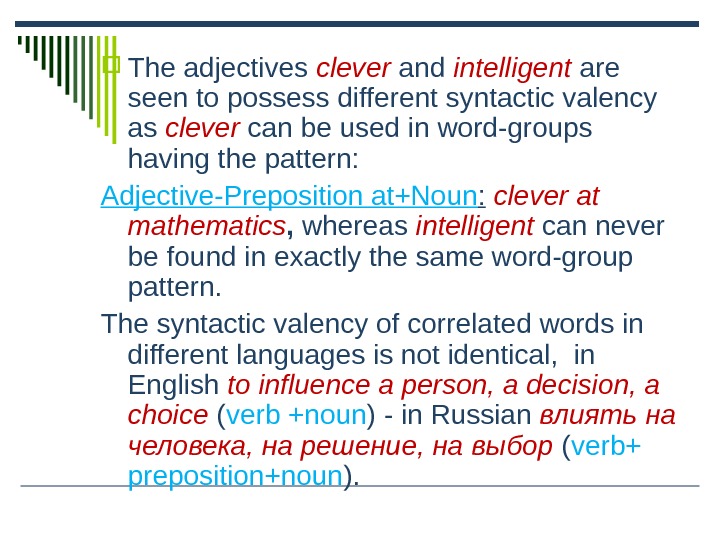
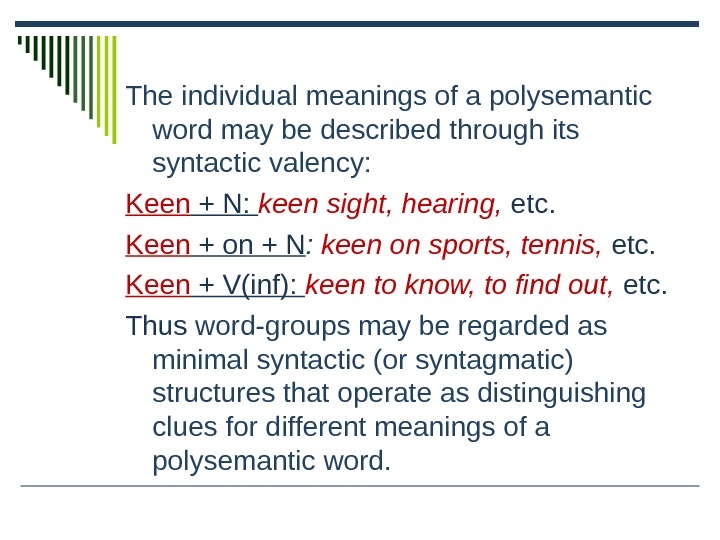
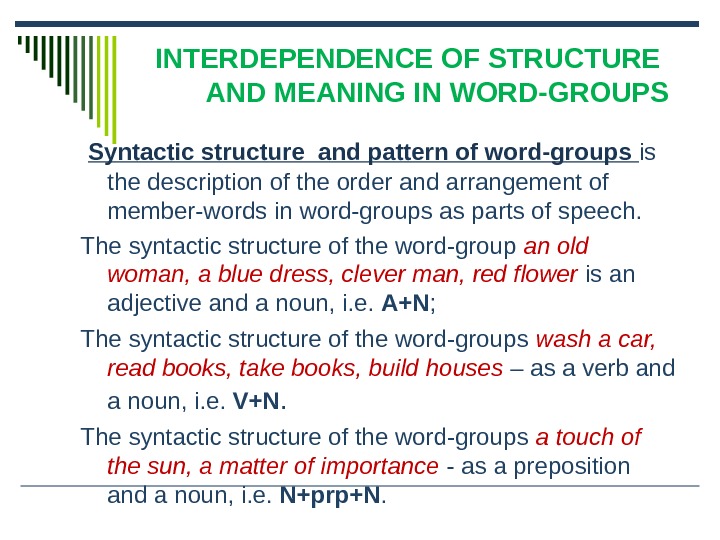
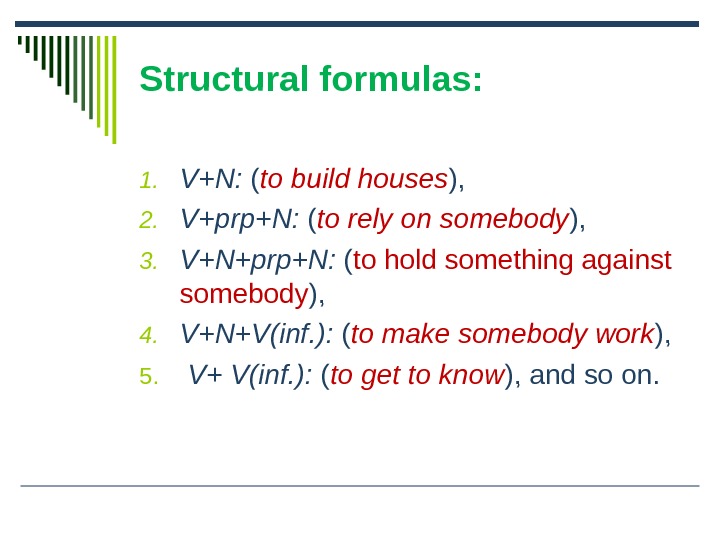
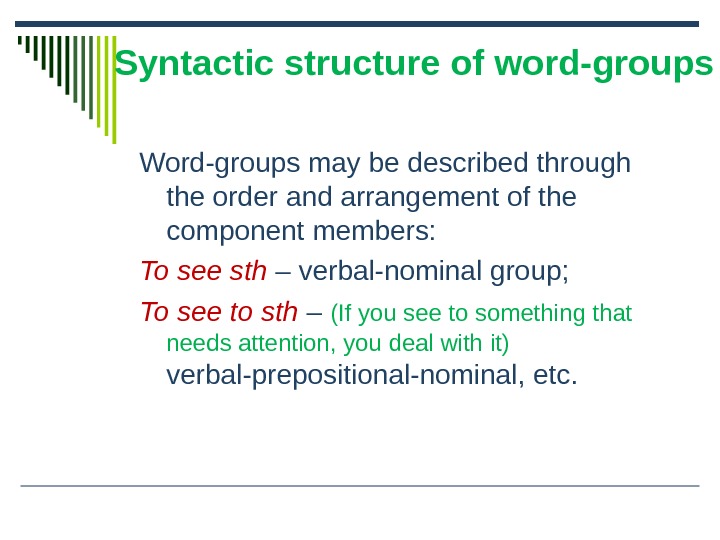
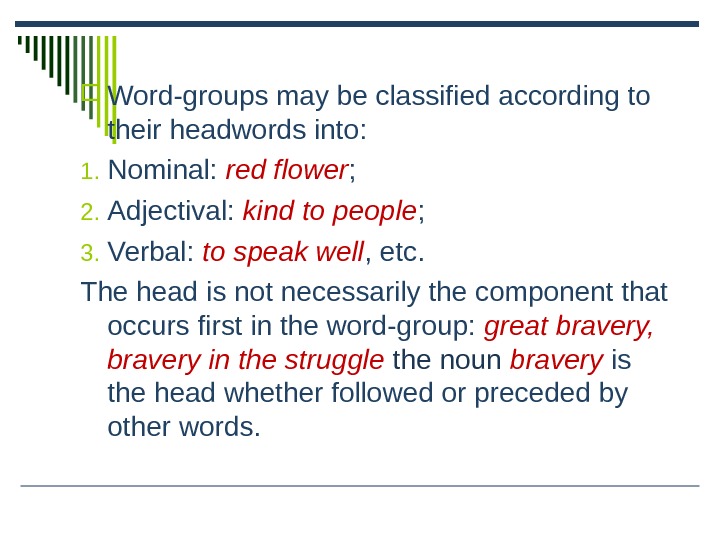
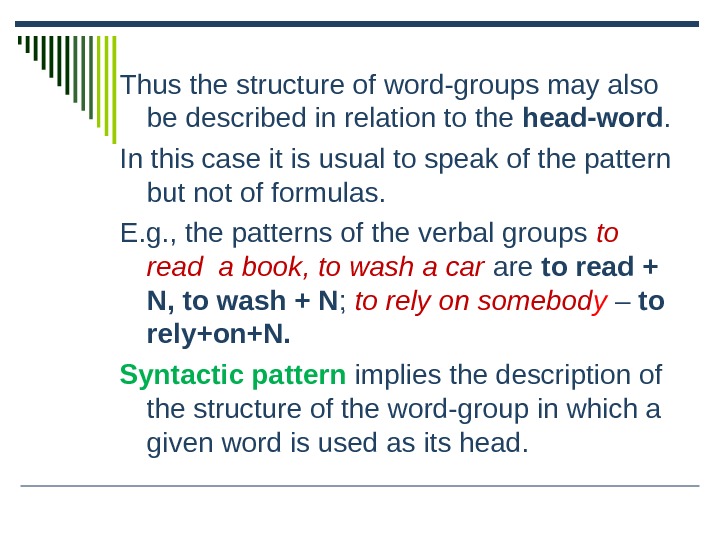

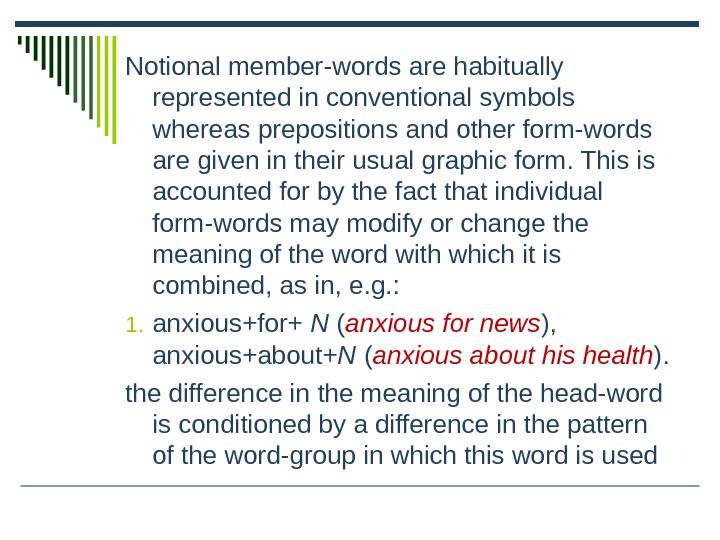
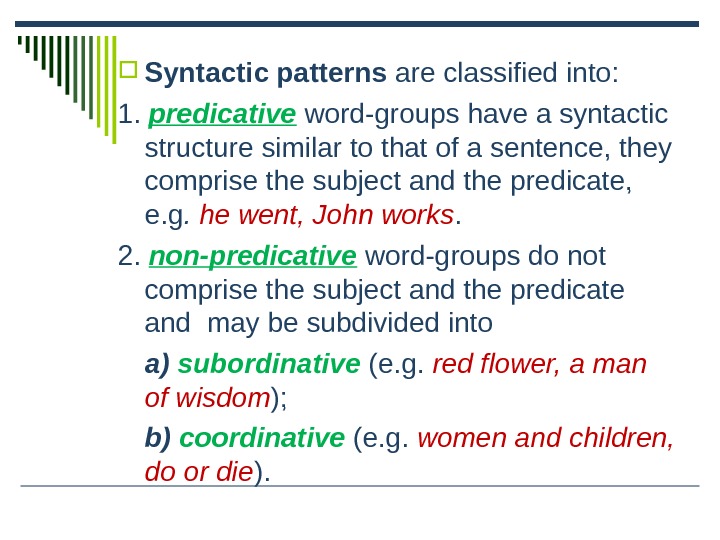
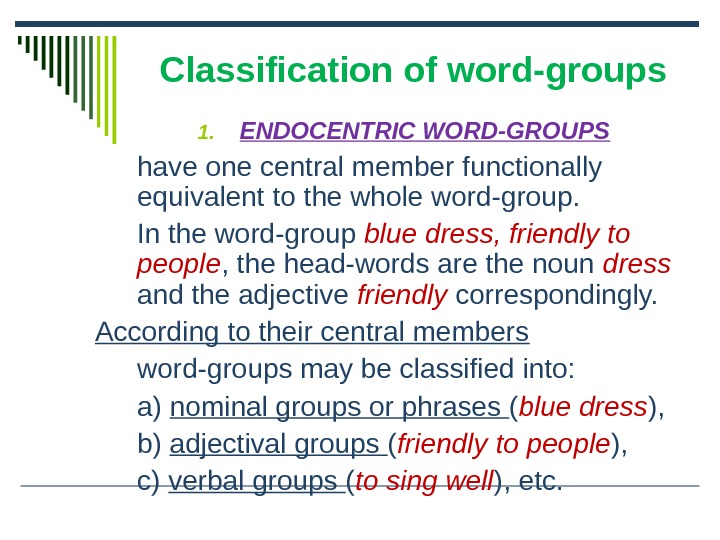
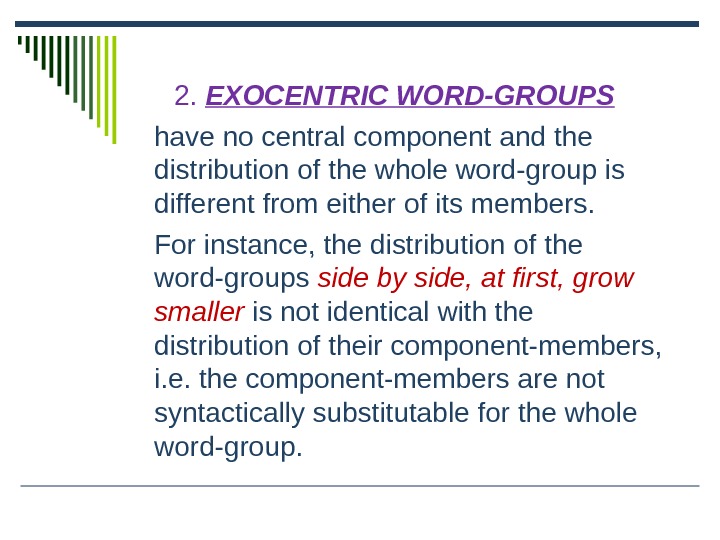
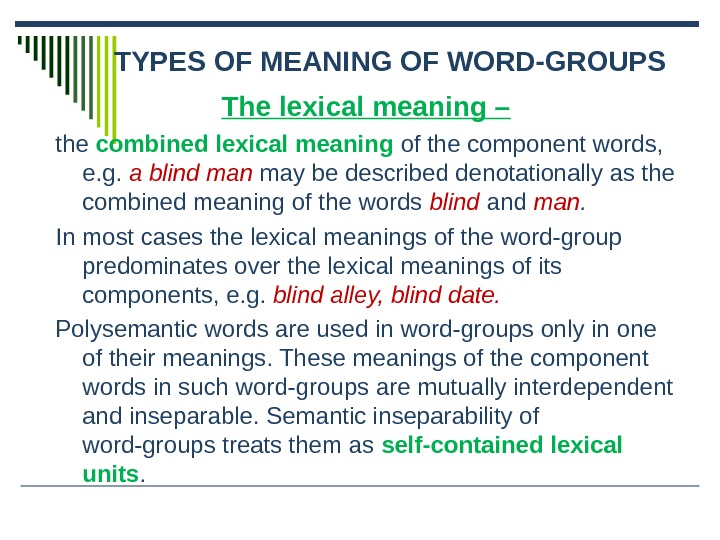
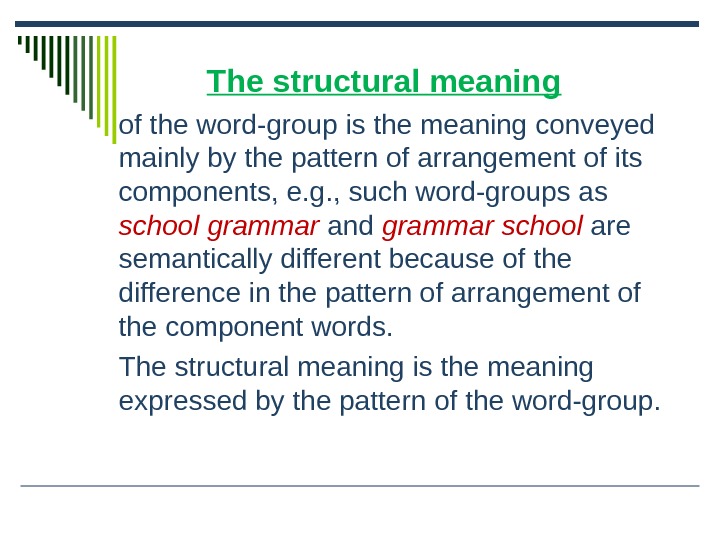
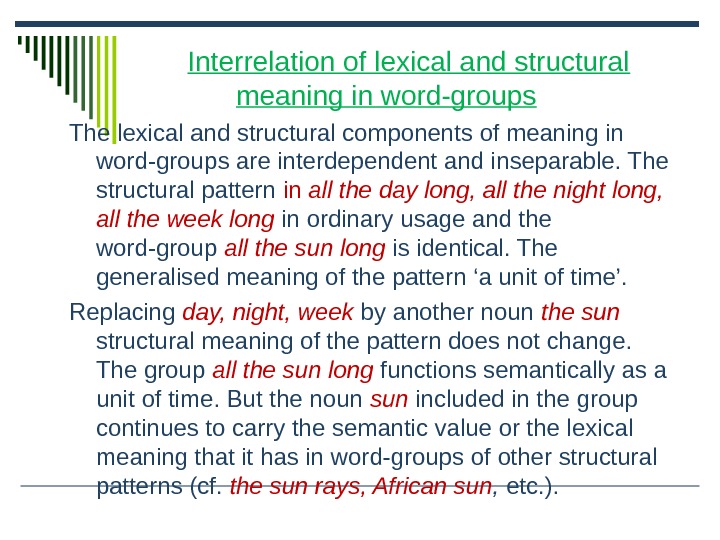
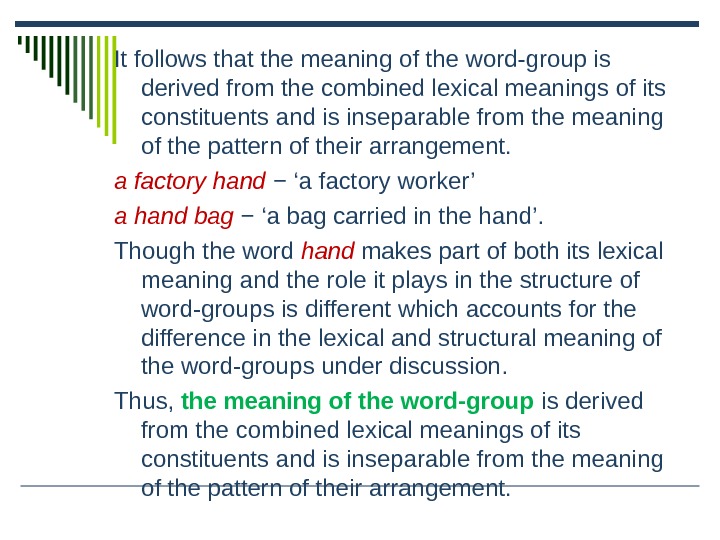
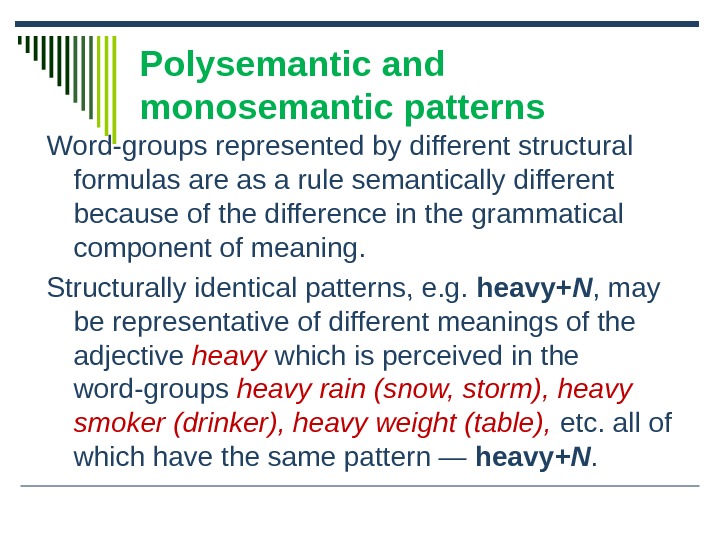
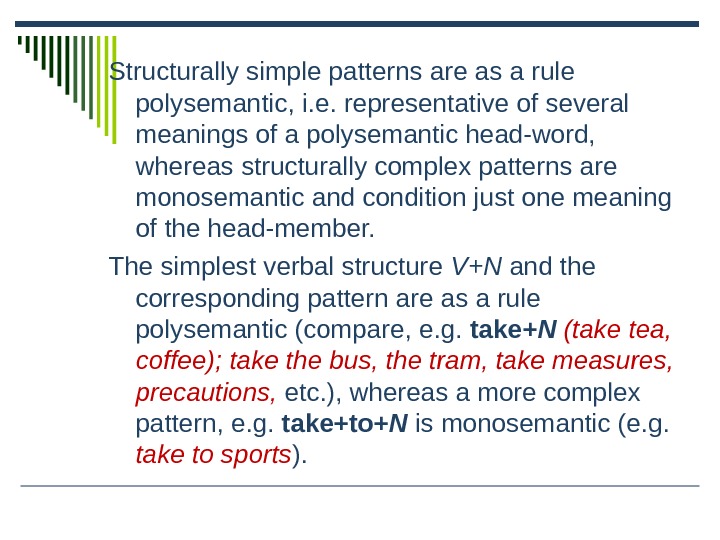
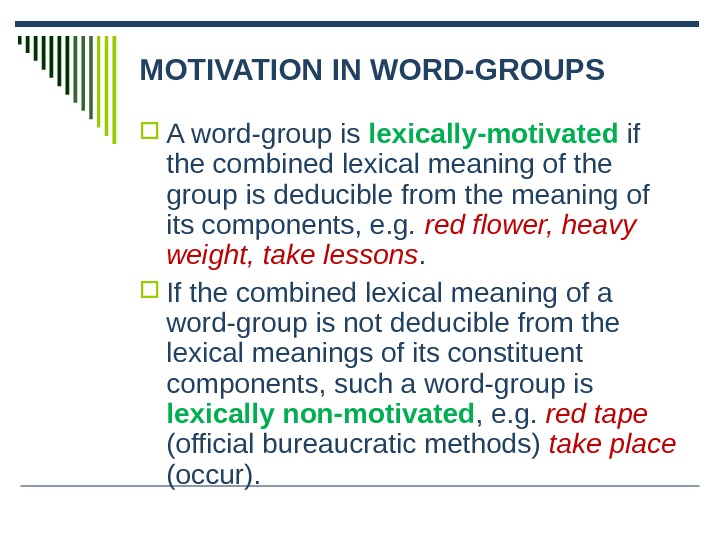
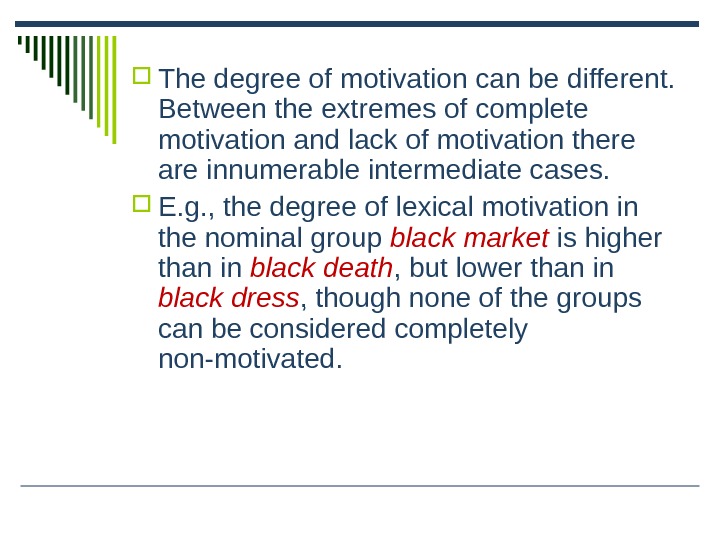
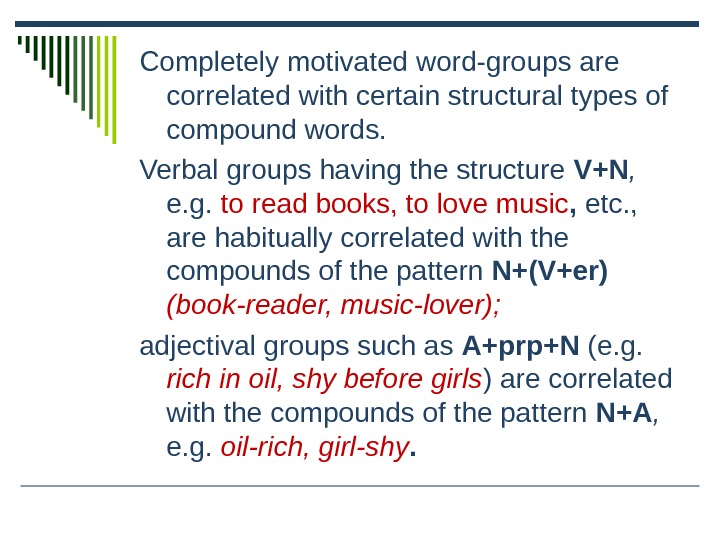
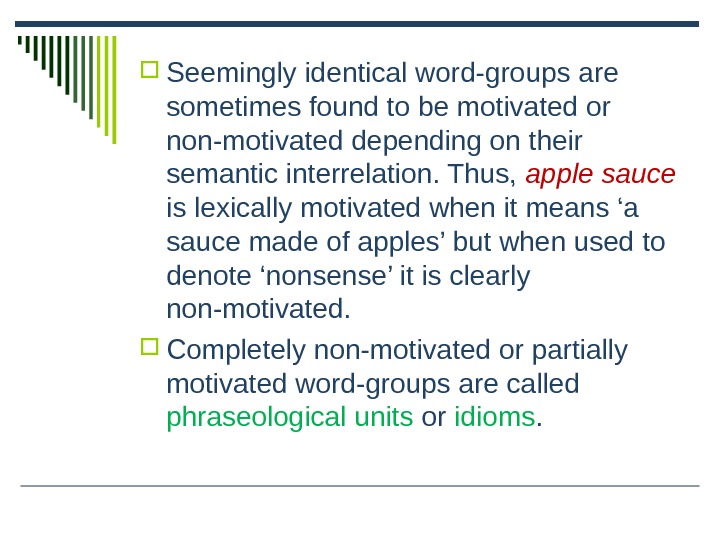
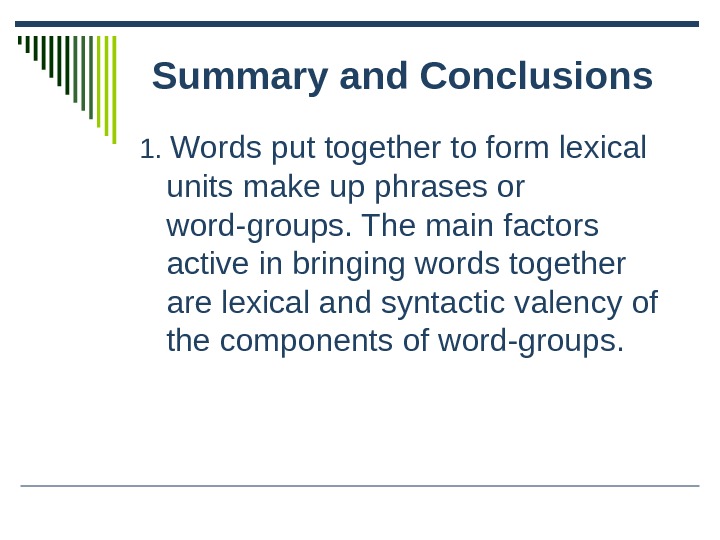
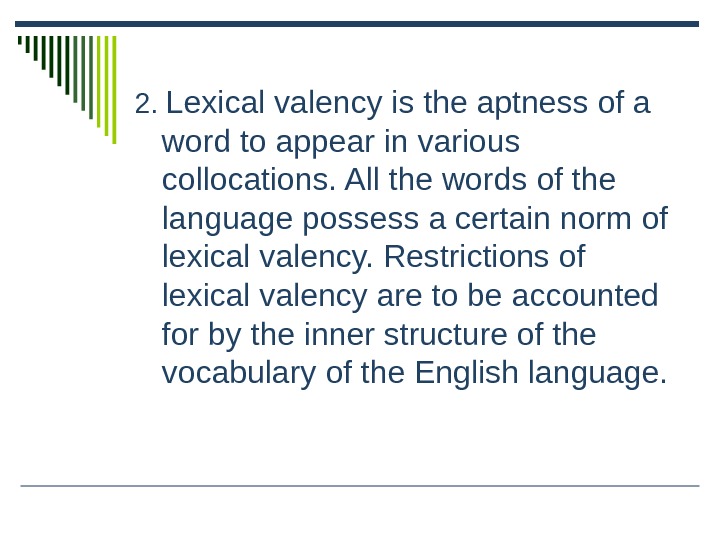
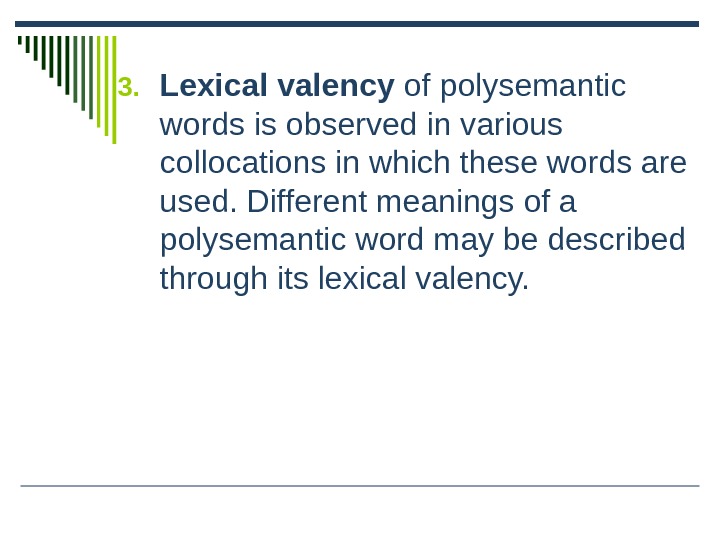
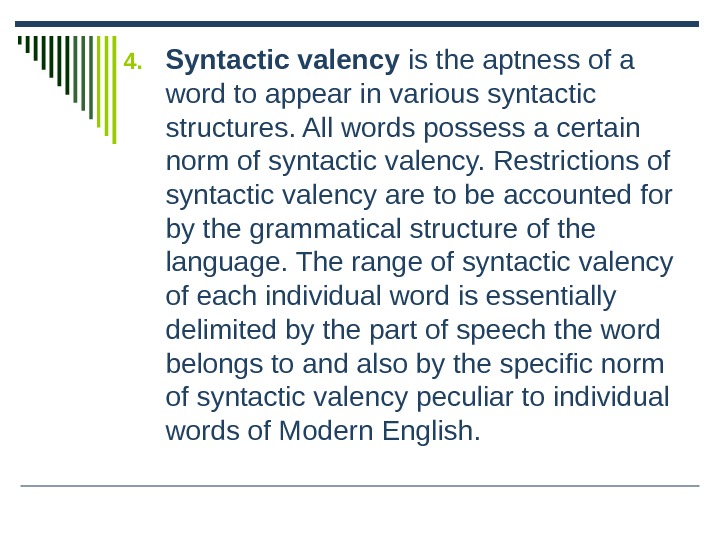
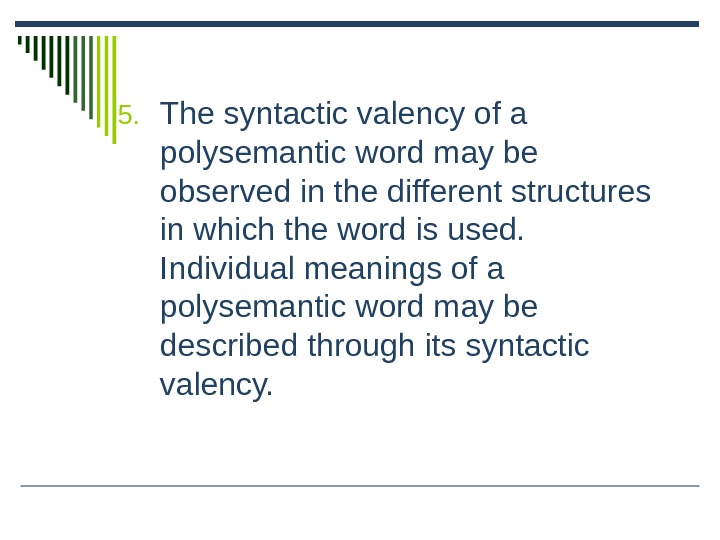
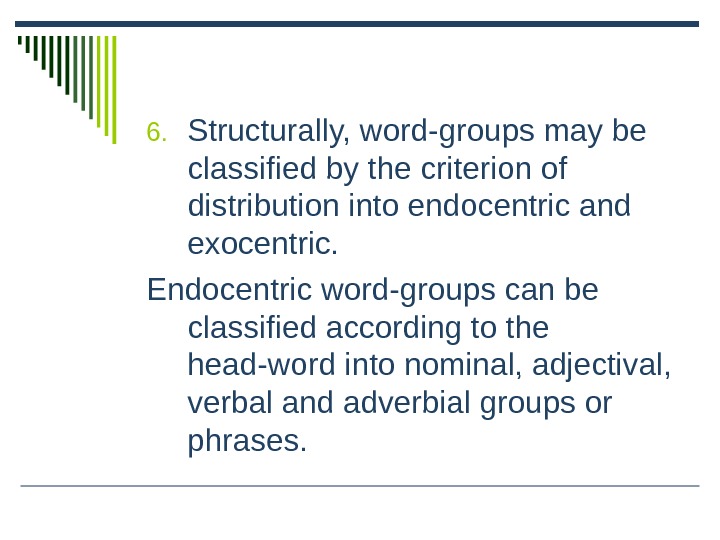
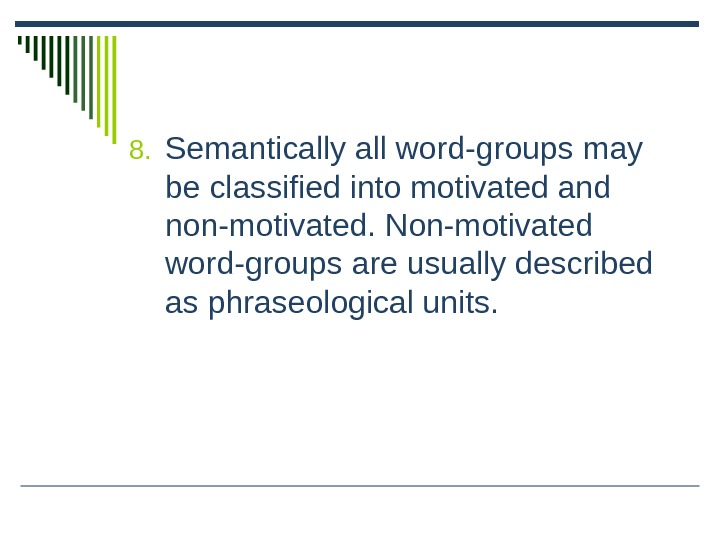
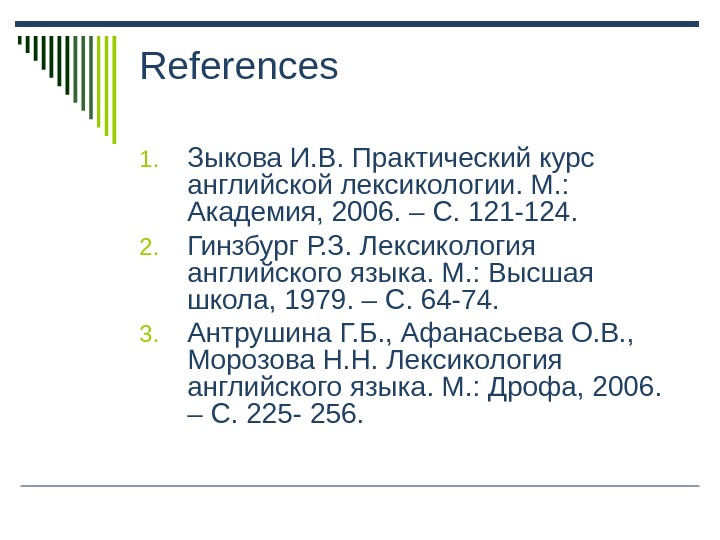

Скачать материал

Скачать материал




- Сейчас обучается 268 человек из 64 регионов




Описание презентации по отдельным слайдам:
-
1 слайд
Word Groups and Phraseological Units
Words put together to form lexical units make up phrases or word-groups.
-
2 слайд
The main factors active in bringing words together are lexical and grammatical valency of the components of word-groups.
-
3 слайд
Lexical valency is the aptness of a word to appear in various collocations.
All the words of the language possess a certain norm of lexical valency.
-
4 слайд
Grammatical valency is the aptness of a word to appear in various grammatical structures.
Restrictions of grammatical valency are to be accounted for by the grammatical structure of the language.
-
5 слайд
Semantically all word-groups may be classified into motivated and non-motivated. Non-motivated word-groups are usually described as phraseological units.
-
6 слайд
The same as words phraseological units express a single notion and are used in a sentence as one part of it.
American and British lexicographers call such units «idioms».
-
7 слайд
Phraseological Units
The border-line between free or variable word-groups and phraseological units is not clearly definedthe existing terms are: set-phrases, idioms, word-equivalents
-
8 слайд
Phraseological units are habitually defined as non-motivated word-groups that cannot be freely made up in speech but are reproduced as ready-made units
-
9 слайд
The main characteristic features of phraseological units are:
— stability of the lexical components
— lack of motivationCOMPARE: red flower and red tape
-
10 слайд
Phraseological units can be classified according to the ways they are formed, according to the degree of the motivation of their meaning, according to their structure and according to their part-of-speech meaning.
-
11 слайд
A.V. Koonin classified phraseological units according to the way they are formed.
He pointed out primary and secondary ways of forming phraseological units.
Primary ways of forming phraseological units are those when a unit is formed on the basis of a free word-group :
-
12 слайд
1) transferring the meaning of terminological word-groups:
«launching pad» in its terminological meaning is «стартовая площадка» , in its transferred meaning — «отправной пункт»,
«to link up» — «cтыковаться, стыковать космические корабли» in its tranformed meaning it means -«знакомиться»; -
13 слайд
2) from free word groups by transforming their meaning,
e.g. «granny farm» — «пансионат для престарелых»,
«Troyan horse» — «компьюторная программа, преднамеренно составленная для повреждения компьютера»; -
14 слайд
3) phraseological units can be formed by means of alliteration ,
e.g. «a sad sack» — «несчастный случай»,
«culture vulture» — «человек, интересующийся искусством»,
«fudge and nudge» — «уклончивость». -
15 слайд
4) they can be formed by means of distorting a word group,
e.g. «odds and ends» was formed from «odd ends», -
16 слайд
5) they can be formed when we use some unreal image,
e.g. «to have butterflies in the stomach» — «испытывать волнение»,
«to have green fingers» — »преуспевать как садовод-любитель -
17 слайд
Other ways:
when a phraseological unit is formed on the basis of another phraseological unit; they are:1) conversion, e.g. «to vote with one’s feet» was converted into «vote with one’s f eet»;
-
18 слайд
2) changing the grammar form, e.g. «Make hay while the sun shines» is transferred into a verbal phrase — «to make hay while the sun shines»
-
19 слайд
3)analogy,
e.g. «Curiosity killed the cat» was transferred into «Care killed the cat» -
20 слайд
4) contrast,
e.g. «cold surgery» — «a planned before operation» was formed by contrasting it with «acute surgery»,
«thin cat» — «a poor person» was formed by contrasting it with «fat cat»; -
21 слайд
6) shortening of proverbs or sayings
e.g. from the proverb «You can’t make a silk purse out of a sow’s ear» by means of clipping the middle of it the phraseological unit «to make a sow’s ear» was formed with the meaning «ошибаться -
22 слайд
7)borrowing phraseological units from other languages
e.g. « living space» (German), « to take the bull by the horns» ( Latin) -
23 слайд
Phraseological units sematically are classified according to V.V. Vinogradov :
-phraseological fusions (сращения) kick the bucket
phraseological unities (единства) e.g. the last straw, to ride the high horse
phraseological collocations (сочетания) e.g. to take smth for granted, to have a bite -
24 слайд
Structurally:
Verbal: to run for one’s life, to talk through one’s hat, to make a song and dance about smth.
Substantive: dog’s life, white lie, calf love.
Adjectival: high and mighty, brand new, safe and sound.
Adverbial: high and low, by hook or by crook
Interjectional: my God! Good Heavens!
Найдите материал к любому уроку, указав свой предмет (категорию), класс, учебник и тему:
6 210 144 материала в базе
- Выберите категорию:
- Выберите учебник и тему
- Выберите класс:
-
Тип материала:
-
Все материалы
-
Статьи
-
Научные работы
-
Видеоуроки
-
Презентации
-
Конспекты
-
Тесты
-
Рабочие программы
-
Другие методич. материалы
-
Найти материалы
Другие материалы
- 27.12.2020
- 4749
- 2
- 27.12.2020
- 4947
- 11
- 27.12.2020
- 5785
- 13
- 27.12.2020
- 5022
- 9
- 27.12.2020
- 4057
- 1
- 27.12.2020
- 3882
- 0
- 27.12.2020
- 3905
- 1
- 27.12.2020
- 3300
- 4
Вам будут интересны эти курсы:
-
Курс повышения квалификации «Основы туризма и гостеприимства»
-
Курс повышения квалификации «Организация практики студентов в соответствии с требованиями ФГОС юридических направлений подготовки»
-
Курс профессиональной переподготовки «Организация деятельности помощника-референта руководителя со знанием иностранных языков»
-
Курс профессиональной переподготовки «Корпоративная культура как фактор эффективности современной организации»
-
Курс повышения квалификации «Актуальные вопросы банковской деятельности»
-
Курс профессиональной переподготовки «Уголовно-правовые дисциплины: теория и методика преподавания в образовательной организации»
-
Курс профессиональной переподготовки «Методика организации, руководства и координации музейной деятельности»
-
Курс профессиональной переподготовки «Гостиничный менеджмент: организация управления текущей деятельностью»
-
Курс профессиональной переподготовки «Технический контроль и техническая подготовка сварочного процесса»
-
Курс профессиональной переподготовки «Информационная поддержка бизнес-процессов в организации»























